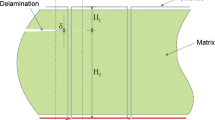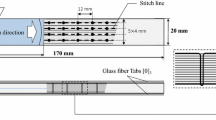Abstract
Two simple micromechanics based models are proposed to predict the effect of through-thickness reinforcement (stitching) on the improvement of delamination crack growth resistance in end-notched flexure (ENF) specimens. In the first model, it is assumed that stitches stretch elastically and then rupture when the load carried approaches the failure load. In the second model, it is assumed that stitches are discontinuous and that the stitch thread-matrix interface is completely frictional. Approximate closed form solutions for energy release rates are obtained, and the effects of stitch density, matrix-stitch thread interfacial shear stress, stitch thread diameter, volume fraction of stitches, critical energy release rate and Young's modulus are then examined. A simple design study for sizing the ENF specimen to minimise geometric nonlinear response is presented. The influences of interlaminar shear deformation and friction between the crack surfaces on the strain energy release rate are examined.
Similar content being viewed by others
References
D.F. Devitt, R.A. Schapery and W.L. Bradley, Journal of Composite Materials 14 (1980) 270–285.
E.F. Rybicki, D.W. Schmueser and J. Fox, Journal of Composite Materials 11 (1977) 470–487.
S.S. Wang, ASME Journal of Applied Mechanics 47 (1980) 64–70.
F.X. DeCharentenay, J.M. Harry, N.J. Prel and M.L. Benzeggah, in Effects of Defects in Composite Materials, ASTM STP 836 (1984) 84–103.
T.K. O'Brien, in Effects of Defects in Composite Materials, ASTM STP 836 (1984) 125–142.
S.N. Chatterjee, R.B. Pipes and R.A. Blake, Jr., in Effects of Defects in Composite Materials, ASTM STP 836 (1984) 161–174.
S.N. Chatterjee, R.B. Pipes and W.A. Dick, Composites Science and Technology 25 (1986) 49–67.
A.J. Russell and K.N. Street, in Progress in Science and Engineering of Composites, T. Hayashi et al. (eds), ICCM-IV, Tokyo, Japan (1982) 279–286.
G. Dorey, S.M. Bishop and P.T. Curtis, Composites Science and Technology 23 (1985) 221–237.
J.K. Kim, C. Baillie, J. Poh and Y.-W. Mai, Composites Science and Technology 43 (1992) 283–297.
J.K. Kim, D. Mackay and Y.-W. Mai, Composites 24 (1993) 485–494.
X.-Z. Hu and Y.-W. Mai, Composites Science and Technology 46 (1993) 147–156.
K.B. Su, in Advances in Thermoplastic Matrix Composite Materials, ASTM STP 1044 (1989) 279–300.
D. Shu and Y.-W. Mai, Composites Science and Technology 47 (1993) 25–33.
M.B. Dow and D.L. Smith, ‘Damage Tolerant Composite Materials Produced by Stitching Carbon Fibres’, 21st International SAMPE Technical Conference, Covina, California (Sept 25–28 1989) 595–605.
D. Liu, Journal of Reinforced Plastics and Composites 1 (1991) 59–69.
L.A. Mignery, T.M. Tan and C.T. Sun, in Delamination and Debonding of Materials, ASTM STP 876 (1985) 371–385.
Y. Ogo, ‘The Effect of Stitching on In-plane and Interlaminar Properties of Carbon Fibre/Epoxy Fabric Laminates’, M. Sci. thesis, University of Delaware, Newark, Delaware (May 1987).
A.B. Macander, R.M. Crane and E.T. Camponeschi, Jr, in High Modulus Fibre Composites in Ground Transportation and High Volume Application, ASTM STP 873 (1986) 422–445.
K. Dransfield, C. Baillie and Y.-W. Mai, Composites Science and Technology 50 (1994) 305–317.
V.A. Guenon, J.W. GillespieJr. and T.-W. Chou, Journal of Materials Science 24 (1989) 4168–4175.
J.-H. Byun, J.W. GillespieJr. and T.-W. Chou, Journal of Composite Materials 24 (1990) 497–518.
L.K. Jain and Y.-W. Mai, Composites Science and Technology 51 (1994) 331–345.
L.K. Jain and Y.-W. Mai, Journal of Applied Composite Materials (1994) in press.
D. Shu and Y.-W. Mai, Composites Science and Technology 49 (1993) 165–171.
G. Farley and L. Dickinson, Journal of Reinforced Plastics and Composites 6 (1992) 633–642.
S.N. Chatterjee, Journal of Composite Materials 25 (1991) 470–493.
S.N. Chatterjee and V. Rammath, International Journal of Solids and Structures 24 (1988) 439–458.
S.P. Timoshenko and J.N. Goodier, Theory of Elasticity, 3rd edn., McGraw-Hill (1970).
J.W. GillespieJr., L.A. Carlsson and R.B. Pipes, Composites Science and Technology 27 (1986) 177–197.
L.A. Carlsson, J.W. GillespieJr. and R.B. Pipes, Journal of Composite Materials 20 (1986) 594–604.
M.D. Greenberg, Foundations of Applied Mathematics, Prentice-Hall (1978).
L.K. Jain and R.C. Wetherhold, Applied Mechanics Reviews 45 (1992) 377–389.
L.K. Jain and Y.-W. Mai, Fatigue and Fracture of Engineering Materials and Structures 17 (1994) 339–350.
Author information
Authors and Affiliations
Rights and permissions
About this article
Cite this article
Jain, L.K., Mai, YW. Analysis of stitched laminated ENF specimens for interlaminar mode II fracture toughness. Int J Fract 68, 219–244 (1994). https://doi.org/10.1007/BF00013069
Received:
Accepted:
Issue Date:
DOI: https://doi.org/10.1007/BF00013069




